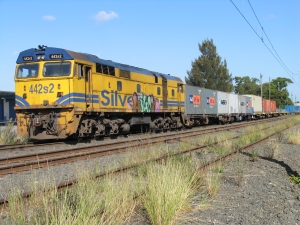
Opinion – Greg Cameron
Australia’s taxpayers will book a net loss of $4 billion when the New South Wales government sells a 99-year lease to Port Botany Container Terminal.
The NSW government is asking taxpayers for $4 billion to build a dedicated freight rail line between Strathfield and the Hawkesbury River. But if container terminal operations were transferred to Newcastle, a dedicated freight rail line could be privately funded and built between Newcastle and a new intermodal terminal (IMT) at Eastern Creek in Sydney’s outer west.
Sydney does not require two north-south dedicated freight rail lines. Cancelling the proposed line between Strathfield and the Hawkesbury River would save taxpayers $4 billion.
One of the advantages of eliminating freight from the Sydney metropolitan rail system is that all rail capacity could be used for passenger services, which would reduce growth in commuter road trips. According to Deloitte Access Economics, if rail was to absorb 30% of the forecast increase in passenger transport demand in Sydney, this could create benefits of over $1 billion a year by 2025. If rail was to take a 40% share in north-south freight movements, there would be a reduction in accident and carbon costs of around $630m a year by 2030.
A dedicated freight rail line between Newcastle and Eastern Creek would connect with the South Sydney Freight Line at Glenfield. It would become the rail component of the ”Outer Western Sydney Orbital Road/Rail Corridor”. However, a commitment to building this line is required immediately because it would have to be operational well before 2028, when freight capacity of the Sydney metropolitan rail system reached its limit.
Combining three major infrastructure projects – Newcastle container terminal, freight rail line to Eastern Creek/Glenfield, and, IMT at Eastern Creek – would allow a price to be set for moving containers that covered construction, financing and operating costs of all three projects. By leasing the government-owned Newcastle site for a container terminal, and leasing or selling the Port Botany container terminal site for airport use, the NSW government would likely achieve its revenue target.
Australia’s superannuation funds are capable of providing the long-term finance.
Construction of Eastern Creek’s IMT must start immediately if there is to be sufficient IMT capacity to cope with future growth in container movements. The Australian government’s IMT at Moorebank would be operating at full capacity of 1.2 million TEU soon after it commenced operations around 2017. If an IMT can be built at Eastern Creek in similar time frame, and a rail link can be built from Port Botany, there would be no need for Moorebank IMT.
Last year, 2 million TEU moved through Port Botany. By 2036, under a high-growth scenario, container movements will be 12.4 million TEU. A low-growth scenario sees container movements of 6.7 million TEU in 2036. Container movements will reach 3.2 million TEU per year before 2020. This is why construction of an Eastern Creek IMT, with expansion capability to meet long-term demand, needs to start immediately.
The NSW government proposes building a freight rail line between Chullora and Eastern Creek. An alternative is to build the line from Glenfield to Eastern Creek and use it to rail containers from Port Botany via Glenfield, until the Newcastle line and container terminal were completed.
The immediate question is whether the Australian government will commit $4 billion to funding the dedicated freight rail line between Strathfield and the HawkesburyRiver, and billions to the proposed West Connex motorways, as requested by the NSW government.
Neither the Prime Minister, nor the Leader of the Opposition, have declared a position.
Well might a decision inconvenience politicians, but it would benefit taxpayers, and voters.





